Excerpts from Jim Conrad's
Naturalist Newsletter
from the October 29, 2007 Newsletter issued from Yerba Buena Clinic just outside Pueblo Nuevo Solistahuacan, Chiapas, MÉXICO
about 1740 meters in elevation, ± LAT. 17° 11' 27"N, LONG. -92° 53' 35"W
MEXICAN LOBELIA
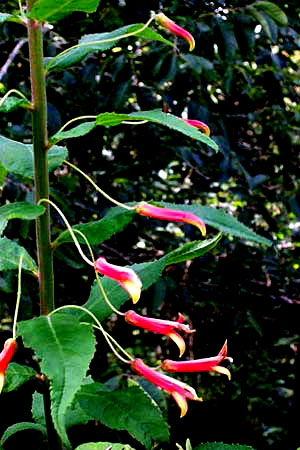
Breedlove's "Flora of Chiapas" lists 15 species of Lobelia for the state. In eastern North America the best-known Lobelias are the red-flowered Cardinal-flower and the much smaller, blue-blossomed Indian Tobacco. Most of our Chiapan Lobelias seem to be of the small, blue-flowered kind, but one common, red-flowered species is unlike any Lobelia I've ever seen, as shown at the right.
That's LOBELIA LAXIFLORA, a common wildflower in much of Mexico and growing at a woods' edge here.
With those very long, gracefully arching pedicels and the similarly gracefully curving blossoms, the flowers remind me of the Yucatan's pink flamingos. In fact, I wasn't sure I even had a Lobelia until I dissected a blossom and saw the matchstick-like structure shown below.
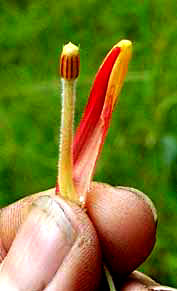 In that picture the tilted, yellowish-red thing is the split corolla, while the matchstick-like structure is the flower's fused-together stamens. The cream-colored bottom part of the "matchstick" consists of the stamens' filaments while the brown, ridged "head" is formed by united, pollen-producing anthers forming a tube or ring around the female style. When botanists see bilaterally symmetrical corollas inside which five stamens grow together in this exact manner, it's a good bet that the plant is a Lobelia.
In that picture the tilted, yellowish-red thing is the split corolla, while the matchstick-like structure is the flower's fused-together stamens. The cream-colored bottom part of the "matchstick" consists of the stamens' filaments while the brown, ridged "head" is formed by united, pollen-producing anthers forming a tube or ring around the female style. When botanists see bilaterally symmetrical corollas inside which five stamens grow together in this exact manner, it's a good bet that the plant is a Lobelia.
My Plantas Medicinales de Mexico, which calls the species by the name of Chilpanxochitl, regards its root bark as toxic and narcotic, making an "energetic" emetic, and tending to paralyze the respiratory system.
entry from field notes dated January 17, 2023, taken along steep, one-lane gravel road ascending forested, northeast-facing mountain slope, elevation ±2,380m (7600 ft); bedrock of intrusive, igneous gradodiorite and diorite; on the south side of Pinal de Amoles, Querétaro state, MÉXICO, (N21.134°, W99.629°)
MEXICAN LOBELIA CLOSER LOOK

Since making the previous entry from Chiapas, much more information has been developed about the Mexican Lobelia, and I now have a better camera. The above picture shows that not only are the flowers' pedicels slender and gracefully curved, but also branches off the main semi-woody stem.
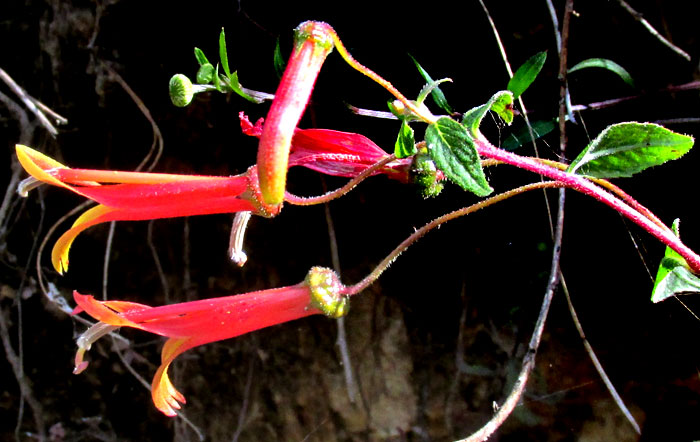
Above, you can see how the bilaterally symmetrical and otherwise tubular corolla is deeply split down its top, and that the fused stamens surrounding the ovary's style bend upward, so that they project through the split in the corolla's top.
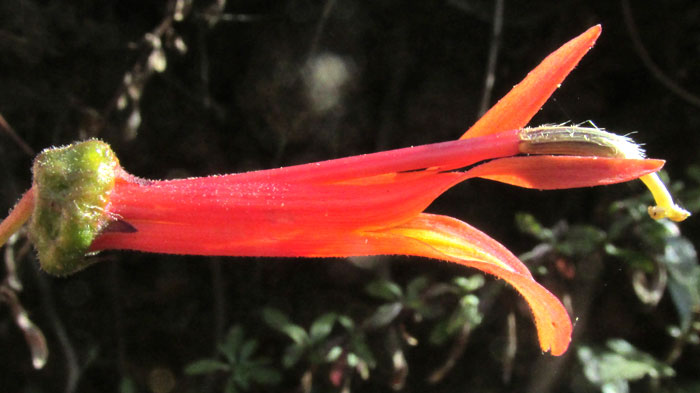
That top-split corolla is significant when you want to discern Lobelia species from other genera in the family to which Lobelia belongs, the Bell Flower Family, the Campanulaceae. In this part of the world, if you have a member of that family whose corollas display bilateral symmetry, most leaves arise singly at stem nodes, and the corolla is deeply split down the top, it's the genus Lobelia.
The genus Lobelia is a big one, probably comprising over 400 species worldwide, mostly in tropical and warm temperate regions. Mexico is home to at least 50 species, concentrated in highland oak and coniferous forests. With so many species to choose from, it's worth noticing vegetative features:
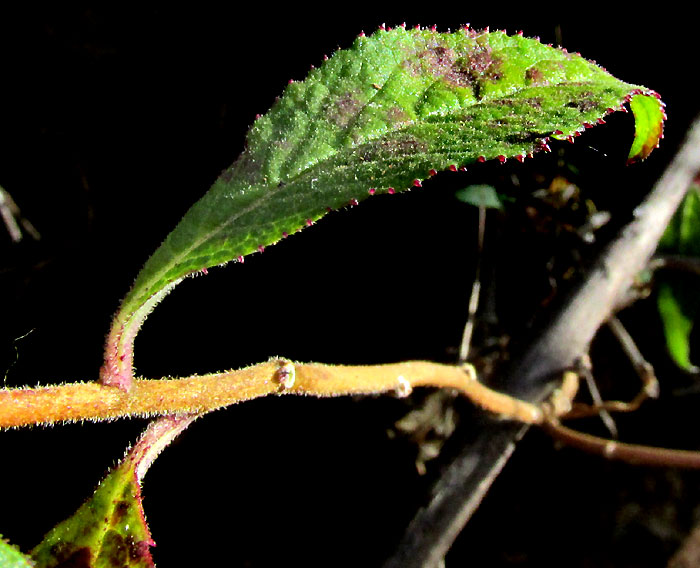
You can see that the leaves and stem are somewhat stiffly short hairy, and that leaves arise one at each stem node.
The Flora del Bajío covering our part of dry, upland, central Mexico documents about 15 species. And in the Bajío region if you have a Lobelia with reddish to yellow flowers, not blue to whitish, and if inside the corolla it's orangish or yellow, you have Lobelia laxiflora. By far most of our species are blue to whitish.
The Mexican Lobelia is regarded as an exceptionally variable, or polymorphic, species. Varieties have been described, mostly on terms of the form and size of the leaves, inflorescence structure, and variations of hairiness -- features considered by some to be undependable, plus it's seen that often the distributions of varieties overlap, and plant features intergrade.
The Mexican Lobelia is fairly commonly distributed mostly in semiarid highlands from the southwestern US south through Mexico and Central America into Colombia in northwestern South America. Occasionally it's planted in gardens.
It's not surprising to find the Mexican Lobelia used in traditional ceremonies, often just as a pretty decoration. The Malezas de México page for the species mentions its root being used medicinally as an emetic (induces vomiting), expectorant (helps one spit out sputum), and for the treatment of asthma.